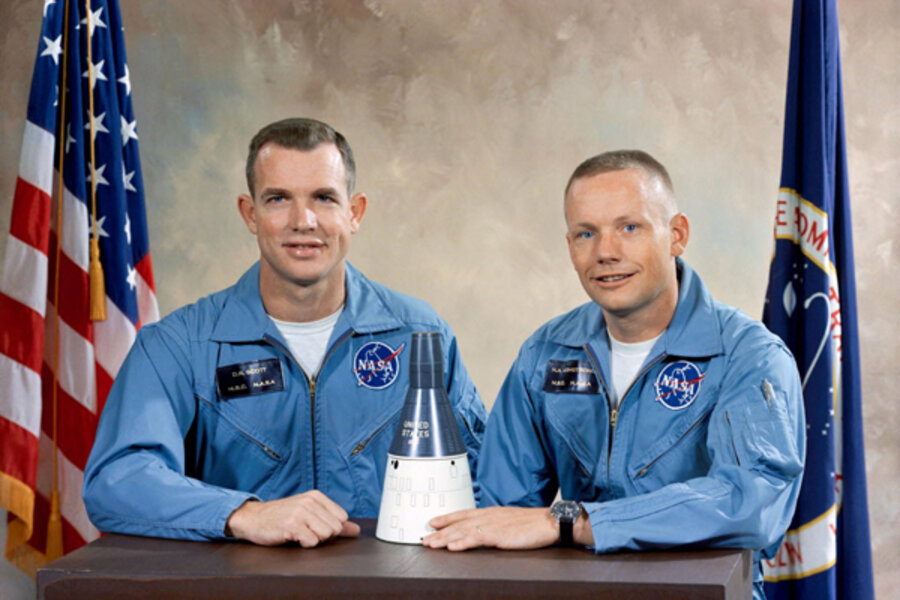NASA's pioneering astronauts: Where are they now?
As space exploration has become more common and the number of astronauts has risen past 300, many names have faded into the background. But some will forever be associated with the golden age of space exploration. Some examples:
From 1969's Apollo 11, the first manned moon landing mission:
— Buzz Aldrin: Lunar module pilot for Apollo 11. Second man on the moon after commander Neil Armstrong. Left NASA in in 1971 and returned to Air Force. Wrote several books including "Return to Earth" and "Men from Earth." Advocate for future U.S. space exploration and frequent lecturer. Age: 82.
— Neil Armstrong: Commander of Apollo 11 mission and first human to set foot on the moon. Left NASA in 1971, taught engineering at the University of Cincinnati, and later became chairman of electronic systems companies. Died Aug. 25 at age 82.
— Michael Collins: Command module pilot on Apollo 11 and circled the moon while colleagues Neil Armstrong and Buzz Aldrin landed. Left NASA in 1970 and became first director of the Smithsonian Institution's National Air and Space Museum in Washington. Wrote "Carrying the Fire," considered one of the best insider space books. Age: 81.
Some other notable astronauts:
— Scott Carpenter: Second American to orbit the Earth in 1962. With John Glenn, surviving member of NASA's original Mercury 7 astronauts. Gave the famous send off — "Godspeed, John Glenn." Involved in Navy's SeaLab program, and spent 30 days under the ocean in 1965. Left the Navy in 1969. Age: 87.
— Eugene Cernan: Commander of Apollo 17 in 1972; last astronaut to walk on the moon. Second person to walk in space in 1966 as a pilot on Gemini 9.
Retired from the Navy in 1976 and later started an aerospace consulting company in Houston. Age: 78
— John Glenn: First American to orbit the Earth in 1962, circling three times in five hours. Left NASA in 1965 and retired from the Marine Corps the next year.
Became a Democratic U.S. senator from Ohio and ran briefly for president in 1984. Return to space in 1998 for a nine-day mission aboard space shuttle Discovery, becoming at age 77 the oldest person in space. Turned 91 in July.
— Jim Lovell: Commander of Apollo 13 in 1970, his fourth space flight. Oxygen tank in the spaceship exploded and the moon mission was aborted. Left NASA in 1973 and became a business executive. Age: 84.
— Edgar Mitchell: The sixth man to walk on the moon in 1971 after maneuvering the landing module from Apollo 14. Made two excursions to collect lunar samples with Alan Shepard. Left NASA in 1972 and went on to become an educator, lecturer and consultant. Age: 81.
— Alan Shepard: First American in space; made a 15-minute suborbital flight in 1961. Returned to space as commander of Apollo 14 in 1971; used a lunar sample scoop with an attached golf-club head to hit a ball on the moon. Retired from NASA in 1974 and went into private business in Houston. Died in 1998 at age 74.
— Jack Swigert Jr.: Pilot for Apollo 13 in 1970, a last-minute replacement after another astronaut came down with the measles. Mission to moon was aborted after an oxygen tank on the spaceship exploded. Left NASA in 1977. Elected to Congress in November 1982; died of bone cancer the next month at age 51.
— John Young: First person to fly into space from Earth six times — seven times counting his lunar liftoff in 1972. Flew two Gemini and two Apollo missions. Commander of the first space shuttle flight, aboard Columbia in 1981. Final space flight in 1983 aboard Columbia. Retired from NASA in 2004. Age: 81.






